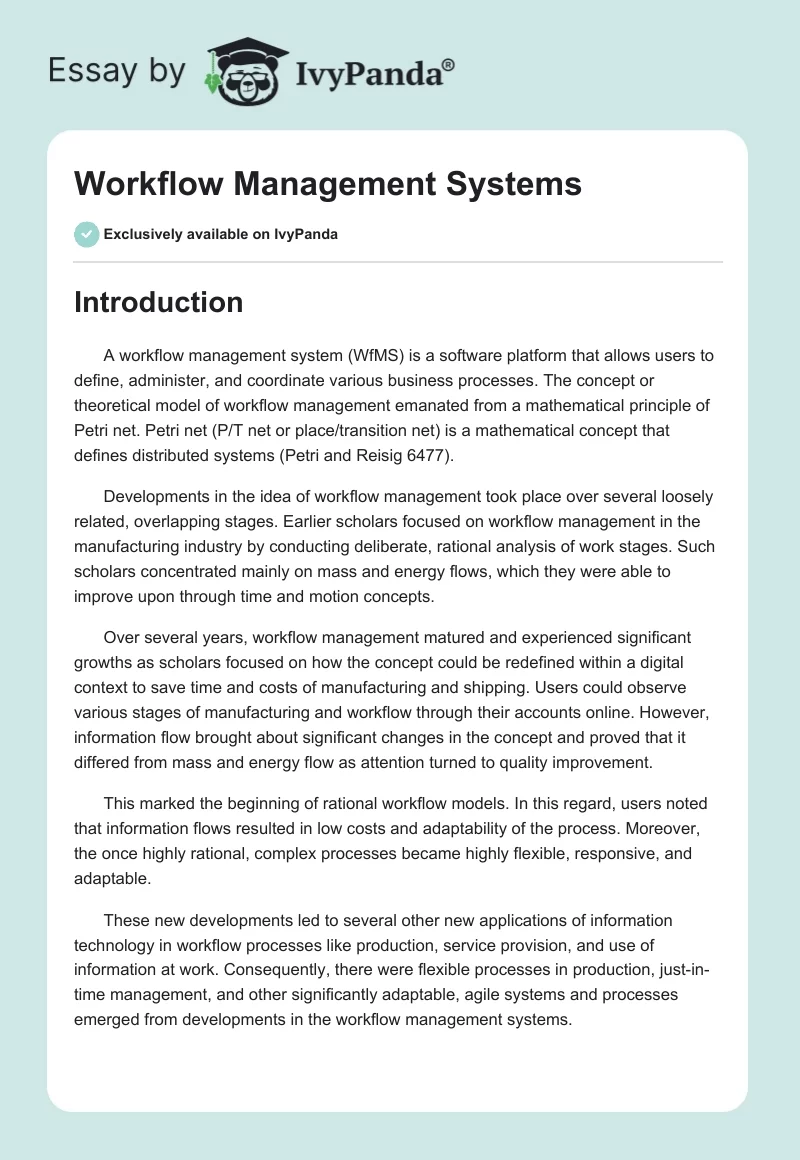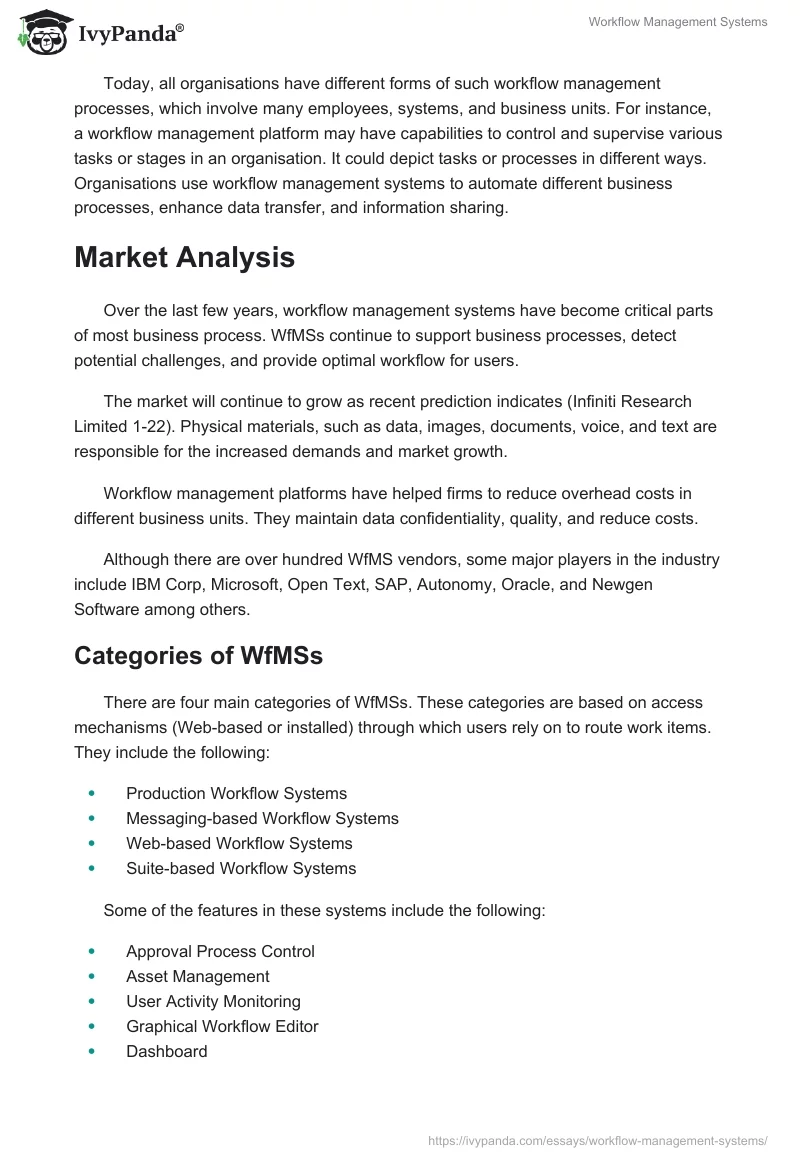Introduction
A workflow management system (WfMS) is a software platform that allows users to define, administer, and coordinate various business processes. The concept or theoretical model of workflow management emanated from a mathematical principle of Petri net. Petri net (P/T net or place/transition net) is a mathematical concept that defines distributed systems (Petri and Reisig 6477).
Developments in the idea of workflow management took place over several loosely related, overlapping stages. Earlier scholars focused on workflow management in the manufacturing industry by conducting deliberate, rational analysis of work stages. Such scholars concentrated mainly on mass and energy flows, which they were able to improve upon through time and motion concepts.
Over several years, workflow management matured and experienced significant growths as scholars focused on how the concept could be redefined within a digital context to save time and costs of manufacturing and shipping. Users could observe various stages of manufacturing and workflow through their accounts online. However, information flow brought about significant changes in the concept and proved that it differed from mass and energy flow as attention turned to quality improvement.
This marked the beginning of rational workflow models. In this regard, users noted that information flows resulted in low costs and adaptability of the process. Moreover, the once highly rational, complex processes became highly flexible, responsive, and adaptable.
These new developments led to several other new applications of information technology in workflow processes like production, service provision, and use of information at work. Consequently, there were flexible processes in production, just-in-time management, and other significantly adaptable, agile systems and processes emerged from developments in the workflow management systems.
Today, all organisations have different forms of such workflow management processes, which involve many employees, systems, and business units. For instance, a workflow management platform may have capabilities to control and supervise various tasks or stages in an organisation. It could depict tasks or processes in different ways. Organisations use workflow management systems to automate different business processes, enhance data transfer, and information sharing.
Market Analysis
Over the last few years, workflow management systems have become critical parts of most business process. WfMSs continue to support business processes, detect potential challenges, and provide optimal workflow for users.
The market will continue to grow as recent prediction indicates (Infiniti Research Limited 1-22). Physical materials, such as data, images, documents, voice, and text are responsible for the increased demands and market growth.
Workflow management platforms have helped firms to reduce overhead costs in different business units. They maintain data confidentiality, quality, and reduce costs.
Although there are over hundred WfMS vendors, some major players in the industry include IBM Corp, Microsoft, Open Text, SAP, Autonomy, Oracle, and Newgen Software among others.
Categories of WfMSs
There are four main categories of WfMSs. These categories are based on access mechanisms (Web-based or installed) through which users rely on to route work items. They include the following:
- Production Workflow Systems.
- Messaging-based Workflow Systems.
- Web-based Workflow Systems.
- Suite-based Workflow Systems.
Some of the features in these systems include the following:
- Approval Process Control.
- Asset Management.
- User Activity Monitoring.
- Graphical Workflow Editor.
- Dashboard.
- Automatic Notifications and Messaging Systems.
- Help Desk Management.
- Resource Management.
- Event-Based Notifications.
- Configurable Workflow.
Messaging-based Workflow Systems
This segment represents the low-end market in WfMSs, and they can be stand-alone platforms or parts of a whole system. These systems send electronic mails and files.
Advantages
The products are low-cost because they rely on available e-mail systems. They are also effective for simple business processes. Moreover, such platforms require minimum training and customisation.
Cons
These platforms lack flexibility and are not comprehensive enough to support several functions. Some of these systems may lack document image processing and management capabilities.
Production Workflow Systems
These systems represent the oldest categories in the market. They are also forms management systems for routing folders to different business units. They have storage capabilities in a central repository unit. Users can gain access to such files at update them.
Pros
They support several features, allow for customisation, and can run on several platforms, including network and computing environments. These products have dominated the market for a long time, and they may have good reputation and advanced features.
Cons
These systems are expensive. Integration processes require highly skilled employees or external consultant, who may be expensive for an organisation. In some cases, they may not be compatible with certain platforms and may require additional platforms to run.
Suite-based Workflow Systems
The product category provides a suite of integrated applications, such Microsoft Office Suite. The system consists of several other platforms, including integrated e-mail applications.
Pros
These platforms are readily available from vendors or distributors. They require no or few changes during implementation, and any third party support or consultants may not be necessary.
Cons
Some of these suite-based workflow systems require regular maintenance and only provide low capabilities for users. In addition, some low-end products in this category may be unstructured to support complex work processes or facilitate structured workflow processes.
Web-based Workflow Systems
These systems have dominated the market since the invention of the WWW. They rely on the popularity of the Web to deliver superior workflow capabilities to users. They rely on Web clients and servers to run.
Pros
Many organisations have the primary network and technology skills required for implementation of these products. The Web has allowed these platforms to provide highly flexible systems, which facilitate work processes, enhance telecommuting and any other flexible work processes. Such platforms may allow for scalability because they run on existing network structures.
Cons
These systems require highly specialised skills for developing and deploying. Moreover, end-users also may require training in order to use such systems. In some cases, the platform may require additional software, such as Java to run.
Security of Web-based applications has always been an issue, particularly when they transfer important personal details and sensitive information about an organisation in vulnerable networks.
Vendors develop new applications at a rapid rate than expected and there is no single platform, which can serve as the standard for the industry.
Web-based platforms may be expensive for most organisations.
Importance of Workflow Management Systems
- Facilitate change
Workflow management systems provide good opportunities for organisations to change their processes and enhance efficiency for competitive advantages.
- Re-engineering opportunities
Since these systems allow organisations to change their business processes, firms can still rely on them to review their business processes and initiate reengineering strategies.
- Increased data access
One major advantage of workflow management systems is information sharing. Thus, employees can share best practices and knowledge. They enhance knowledge development, sharing, and storage of corporate knowledge. Thus, employees can again access to information they require easily. Such platforms are useful for new employees who may lack knowledge about an organisation and its processes.
- Security and reliability
Most of these platforms offer secure storage and access for sensitive data about an organisation. They organise data from different sources and ensure data integrity within an organisation through access control and privileges, process control, version updates, back-ups, and data reliability.
Comparison of the UAE (United Arab Emirates) against International markets
Americans dominate the WfMS market. They control more than 55 percent of the global market share (Infiniti Research Limited). However, WfMSs have also spread to other regions globally. Although there are no readily available data on adoption and usages of WfMS platforms in the UAE, some major financial institutions apply WfMSs in their business processes.
Amlak Finance deployed a system that run on Microsoft Office SharePoint Server 2007 to cut time spent on approving internal processes and approvals. This was a new technology, which relied on an existing application. The company automated 54 business processes in the first phase and achieved good outcomes.
Bank Dhofar also uses Newgen Software to run its business processes. Consequently, the bank was recognised for its implementation of business process management (BPM) platform to automate loan and credit processes. The Workflow Management Coalition (WfMC) announced “Bank Dhofar as the winner in the Banking and Financial Services under Loan Origination category” (Khan 1).
The WfMC and other vendors worked together to develop the Workflow management reference model. The model highlights APIs, messaging platforms, and conversational pathways required to allow users to send, track, and receive information within an organisation.
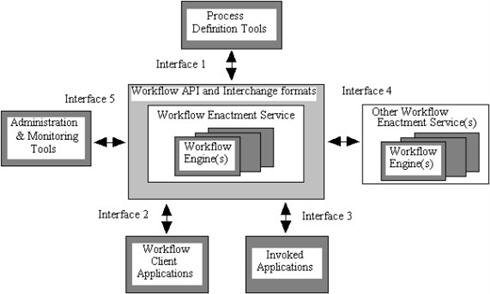
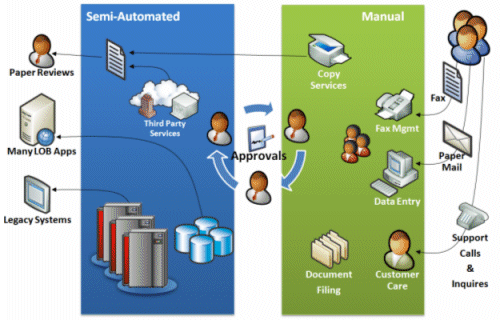
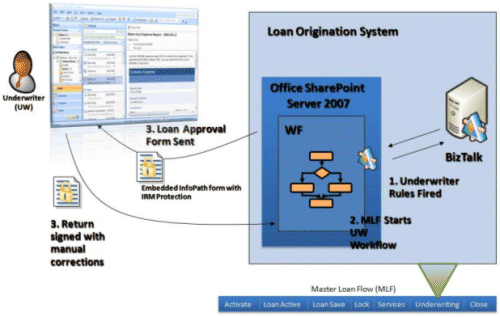

Trends, Perspectives, Recommendation, and Conclusion
Recent trends in information and technology (IT) have resulted in many computation processes. Increased usages have led to demands for new tools, which users will require to handle business processes and growing volumes of data.
From the industry perspectives, WfMSs have matured with time and the market continues to grow. Although there are many vendors of WfMSs, only few vendors dominate the global market. The US commands more than 55 percent of the market. The UAE market is growing as major financial institutions continue to adopt WfMSs and realise their benefits.
The WfMC developed a model in consultation with other vendors to enhance standardisation in the field as new vendors emerge. Different vendors’ products have significant strengths and weaknesses in different areas. Thus, different WfMS platforms may be effective in different processes.
In addition, one must recognise that the IT industry is highly dynamic in terms of product development and innovation. Still, many vendors are unlikely to match fierce competition and survive in the next decades. Thus, organisations should choose their vendors and partners carefully (DiCaterino, Larsen, Tang, and Wang 13).
In recommendation, the growing usages of computation technologies and volumes of data present new challenges and opportunities for users and developers. As a result, vendors must focus on developing new Data Centric Scientific Workflow Management Systems (DSWMSs) to solve emerging issues. The DSWMSs will offer robust alternatives to challenges by leveraging on data manipulation techniques to provide insights based on empirical outcomes.
Works Cited
DiCaterino, Ann, Kai Larsen, Mei-Huei Tang, and Wen-Li Wang. An Introduction to Workflow Management Systems. 1997. Web.
Infiniti Research Limited. Workflow Management Systems Market 2010-2013. 2011. Web.
Khan, Asif. Bank Dhofar Wins Global Award for Excellence in BPM and Workflow. 2014. Web.
Petri, Carl Adam and Wolfgang Reisig. “Petri net.” Scholarpedia 3.4 (2008): 6477. Print.
Walker, Mike. Architecting Enterprise Loan Workflows and Orchestrations. 2007. Web.

